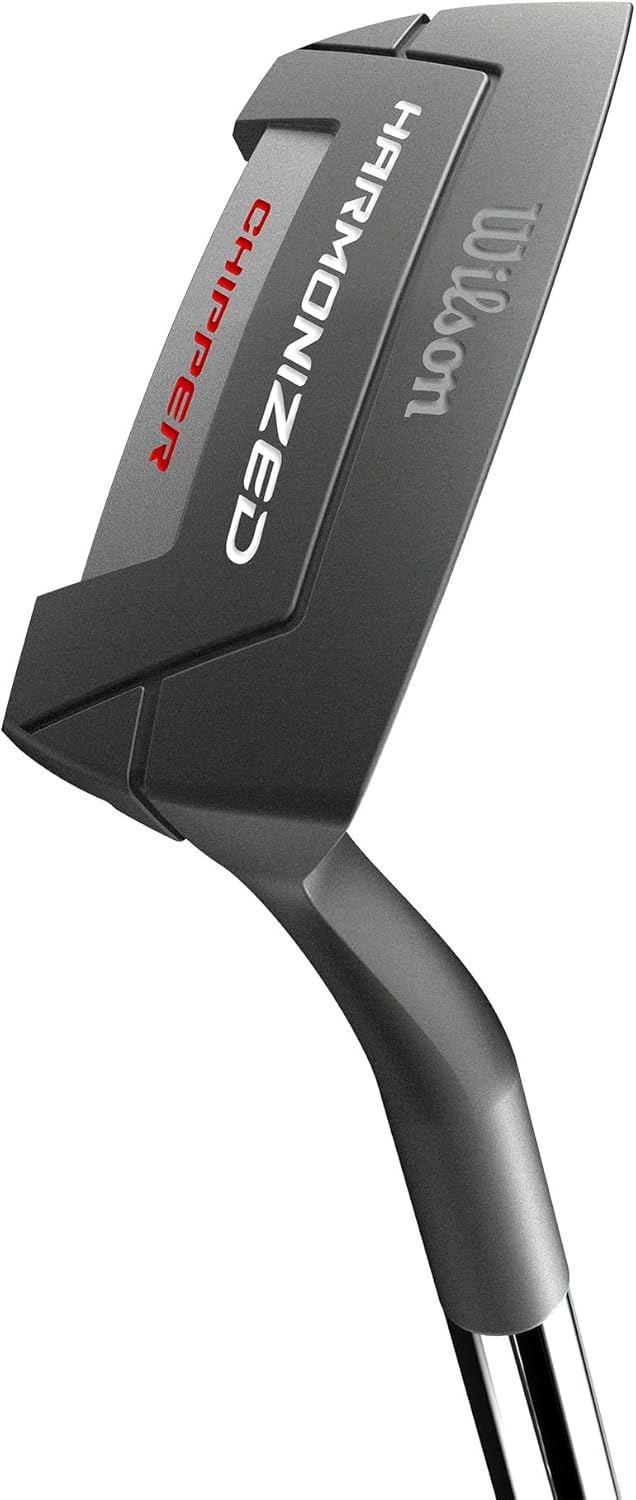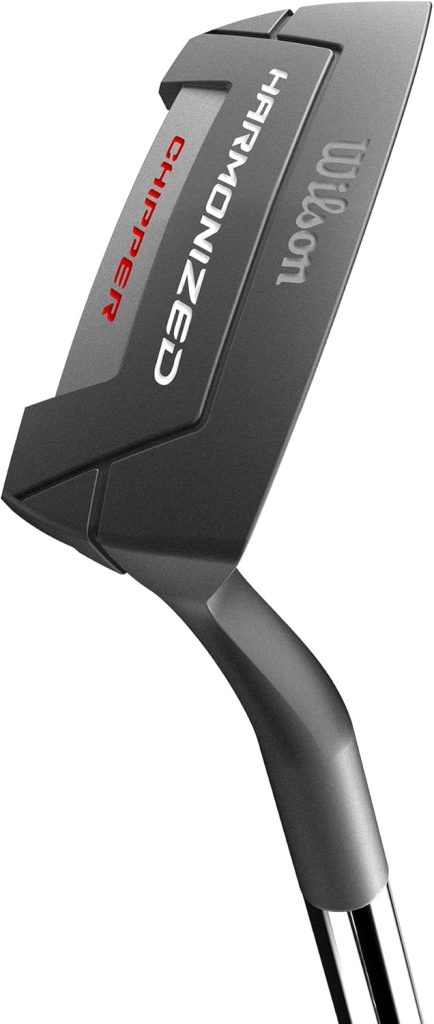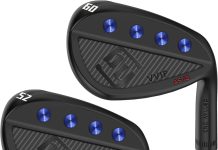Have you ever wished you had a simple club that could rescue you from those awkward fringe and thick-rough situations without overcomplicating the shot?
My full review of “Wilson Harmonized Chippers – 33″ and 35″”
I’ve spent time on the course testing the Wilson Harmonized Chippers — specifically the 33″ and 35″ options — and I want to share everything I learned about how they play, when they’re useful, and whether they’re worth adding to your bag. I’ll be candid about the strengths, the compromises, and the types of golfers who will get the most out of these clubs.
What the product is
The Wilson Harmonized Chipper is essentially a hybrid between a traditional wedge and a putter, designed to simplify short-game choices. The product details emphasize a right-hand, 35″ configuration as a primary offering and describe a fusion between a wedge and a putter that encourages a bump-and-run off the fringe or a deeper scoop from thick grass; it also notes that the loft is similar to a typical 7-iron, which directly affects how the ball launches and rolls.
Key specifications and features
I like to lay out specs in a clear way so I and anyone reading can quickly compare the main features. Below is a compact breakdown of the most relevant specs and intended uses for each size variant.
| Feature | 33″ Model | 35″ Model | Notes |
|---|---|---|---|
| Typical Hand | Right (commonly) | Right (commonly) | Some retailers may offer left-hand, but the widely advertised unit is right-hand. |
| Length | 33 inches | 35 inches | 33″ feels more like a short hybrid, 35″ mirrors a standard chipper/putter length. |
| Head Type | Chipper head (wedge+putter) | Chipper head (wedge+putter) | The design is a true fusion: a low-bounce rounded sole with a flatter face profile. |
| Loft (approx) | Similar to 7-iron | Similar to 7-iron | Allows low-launch bump-and-run and controlled scoops; less loft than typical sand or lob wedges. |
| Primary Use | Tight lies, fringe | Fringe, deeper rough & more reach | 33″ is for control; 35″ gives extra reach and more putter-like stroke length. |
| Typical Stroke | Putters-style stroke with slight tilt | Putters-style stroke with slight tilt | Encourages minimal wrist hinge and a controlled forward stroke. |
I find that having both sizes listed helps golfers quickly understand whether the shorter or longer option will suit their setup and stance preference.
Design and build quality
The Harmonized Chippers have a straightforward and functional aesthetic; Wilson didn’t try to overcomplicate the head shape. The build is solid and feels consistent with the price point: the head has a clean finish, the shaft is stable, and the grip is comfortable for putting-like strokes. I noticed a balance that favors forgiveness over aggressive shot-shaping, which suits mid- to high-handicap players looking for reliability around the greens.
How it feels in my hands
When I first picked up the chipper, it felt familiar yet different: familiar because the grip and shaft setup remind me of a putter, and different because the head sits like a wedge behind the ball. The weight distribution encourages a pendulum motion, which is what the club is aiming for — minimal wrist action, controlled stroke. I felt immediate confidence with short-chips and bump-and-runs, especially from the fringe.
How it performs around the greens
Performance is where the Harmonized Chippers really show what they were designed to do. From light fringe shots, the ball comes off the club low and runs out predictably, which is perfect for bump-and-run tactics. From thicker grass, the rounded sole helps to scoop without digging aggressively, giving me the ability to pop the ball out and stop it near the hole. Because the loft mimics a 7-iron, I noticed less ballooning and a more roll-oriented landing, which suits shots where you want the ball to get to the hole and keep moving.
When I choose to use this chipper
I typically reach for the Harmonized Chipper in two situations: when I’m just off the green on closely-mown turf and when I’m in slightly thicker fringe or light rough and I want a simple escape. It’s not a club I’d use for high, soft shots that demand maximum spin and a steep attack angle; for those I still prefer a sand or lob wedge. Instead, the chipper excels when the goal is a controlled roll or a cleaner, simpler contact.
Technique and setup tips
My approach with this club is deliberately straightforward: set up like I’m putting, make a short pendulum stroke, and let the clubhead do the work. I place the ball slightly back of center in my stance, keep my weight favoring the front foot, and maintain a quiet lower body. The idea is to minimize flicking or excessive wrist hinge so the ball’s interaction with the sole remains consistent.
Bump-and-run specifics
For a bump-and-run, I set the ball back in my stance and use a shallow, putting-style stroke, allowing the low loft to send the ball hopping then rolling toward the hole. Keeping my hands steady and stiffer through impact helps ensure the club’s sole skims the turf without digging. I found that adjusting the length of my stroke controls roll — shorter for slower greens, longer for faster ones.
Scoop from heavy grass
When the ball sits in heavier fringe, I slightly open my stance and make a slightly steeper, yet still compact, stroke that lets the rounded sole work through the grass. The chipper’s design helps reduce the chance of the clubhead grabbing the turf, but it does require commitment to accelerate through the ball. I emphasize a square clubface at impact to prevent accidental pulls or slices when the grass interferes.
Comparing the 33″ vs the 35″
The main difference between the two sizes is feel and leverage. The 33″ model is compact and gives me more control over face angle and trajectory; it’s easier to manipulate for players who prefer a more compact stroke. The 35″ model, being longer, provides a more familiar putting-like length and a smoother pendulum arc, which benefits players who like the posture and stroke length of their putter transferred to chip shots. Both have the same fundamental head design and loft characteristics, so the choice comes down to comfort and preference.
Pros I appreciate
I have a list of strengths that stood out during my rounds. First, the simplicity of the club reduces overthinking — I can commit to a shot more easily. Second, the consistent rollout after contact makes distance control more predictable. Third, the comfort of using a putter-style stroke around the green lowers the chance of bladed chips. Last, the build quality is practical and durable for regular use.
Cons and limitations I noticed
No product is without trade-offs, and the Harmonized Chippers are no exception. Because they have loft similar to a 7-iron, they’re limited when you need a high, soft stopping shot near the pin. Spin is generally lower than with traditional wedges, so when greens are extremely receptive and you need the ball to bite, I revert to a wedge. Additionally, players who love shaping delicate short shots may feel constrained by the chipper’s straightforward nature.
My on-course tests and results
I took the chipper out for multiple rounds and practice sessions, testing a variety of lies and green speeds. My up-and-down percentage improved noticeably on fringe and short-rough scenarios; I felt more confident to run the ball up rather than try to manufacture a high lob. In one round, I saved par from a tricky fringe lie twice within the same nine holes using the chipper, which validated the design intent in real conditions. I also tested it on different green speeds and learned to adjust stroke length and ball position to match the conditions.
Comparing this chipper to a traditional wedge
When I compare the Harmonized Chipper with a wedge, I see two different toolsets for short game problems. The wedge is versatile for a broad spectrum of shots — flop, pitch, delicate stop shots — while the chipper narrows the function to predictability and ease for lower-launch options. If I need a shot to stop quickly and spin, I reach for a wedge; if I need to minimize variables and get the ball in a consistent roll, I pick the chipper.
Comparing this chipper to a traditional putter
Compared with a putter, the chipper allows me to address the ball with the loft and sole geometry necessary for turf interaction, which a putter lacks for anything but a dead square lie. The stroke resembles putting, but the chipper’s head geometry gives me confidence when there’s a little grass or an inconsistent lie. If I tried to hit bump-and-run style shots with a putter from the fringe, I’d risk mis-hits; the chipper is purpose-built for that crossover.
Who should consider buying the Wilson Harmonized Chippers
I think this club is an excellent addition for mid- to high-handicap golfers who struggle with consistency around the greens and want a simple, confidence-building option. Weekend players who prefer a less technical short game will appreciate fewer moving parts in their technique. I’d also recommend it to golfers who frequently face fringe and light rough rather than people who primarily need high, spun shots close to the pin.
Who might want to pass on it
If you are a low-handicap player who relies on precise loft control and spin for short-game scoring, you might find the chipper restrictive. Also, golfers who treasure a full wedge setup for every variety of short shot will likely prefer keeping only wedges in the bag. I’d advise those players to consider adding a chipper as a niche tool rather than a primary replacement.
How to fit the chipper to your game
Fitting a chipper is more about personal comfort than precise bounce or lie angles, though those still matter. I tried both the 33″ and 35″ models and found that my putting stance and stroke length determined which felt more natural. If you putt with shorter strokes and prefer a more compact stance, the 33″ may be better; if your putting stroke is longer and you like the posture of a full-size putter, the 35″ blends more naturally.
Maintenance and care I recommend
Caring for the Harmonized Chipper is straightforward and similar to any other short-game club. I wipe the head after each round to prevent dirt buildup, check the grip for wear, and store the club in a dry place. Periodic loft and lie checks at a shop aren’t strictly necessary unless you suspect damage, but I do regrip when the feel becomes slick to maintain consistent handling.
Price and value — what I think you get
In my experience, the Harmonized Chippers provide solid value: you’re buying a dedicated tool that simplifies a common problem area. The price typically sits below premium short-game specialty clubs, which makes it a low-risk purchase if you want to test the concept. For many golfers, the saved strokes from better up-and-downs can justify the cost quickly.
My recommended practice drills
I used a handful of targeted drills to get comfortable with the chipper, and I recommend them to anyone new to this style of club. One effective drill was placing tees in a line at 5, 10, and 20 feet and practicing controlled strokes to each target to hone distance control. Another drill was alternating between using a wedge and the chipper from identical lies to feel the difference in ball flight and roll; this helped me choose the correct club during rounds with confidence.
Situations where the chipper surprised me
A couple of times I was surprised by how useful the chipper was from odd lies on tight fairway bankings near the green where a wedge would either catch a root or balloon unpredictably. The chipper’s sole allowed me to glide through those spots with a simple forward stroke and get the ball in a reasonable position. It also performed better than expected on moderately sloped lies where a putter would have been risky.
Personal considerations and setup changes
After using the chipper extensively, I made a few small changes to my bag setup and pre-shot routine. I started practicing chipper shots on practice greens to calibrate roll-out for different conditions, and I adjusted my stance to be slightly more forward to stabilize the stroke. These tweaks were minor but improved my confidence and results.
Frequently asked questions I get while testing
I fielded several questions from playing partners while using the chippers; here are the answers I gave them based on my experience. Many golfers wanted to know whether they would lose their wedge skills — my answer was that you’re not replacing a wedge’s versatility, you’re adding a tool for specific situations. Another common question was whether left-hand models exist — they do in some markets, but the most common listing I saw emphasized right-hand, 35″.
Prospective improvements I’d like to see
While I generally liked the Harmonized Chippers, I’d appreciate more color or finish options and a broader range of stock shaft and grip choices from the factory. For players who enjoy customizing feel, a slightly wider selection of lofts or bounce profiles from Wilson would make the chipper even more adaptable. Finally, clearer guidance from the brand on recommended uses for each length could help buyers choose the ideal model faster.
Final verdict and recommendation
Overall, I find the Wilson Harmonized Chippers — both the 33″ and the 35″ — to be practical, confidence-building tools that make many typical short-game situations less intimidating. I recommend them to golfers who want a simpler, more predictable way to handle fringe and short-rough shots and who value consistent rollout over maximum spin. If you struggle with up-and-downs from short grass and want to lower your scores with a straightforward solution, I think this chipper is worth a trial.
Quick summary of key points I keep coming back to
I appreciated the predictable roll, the putter-like stroke, and the relief from overcomplicated technique around the green. The trade-offs are limited versatility for high, spinning shots, but for many golfers the benefits in reduced stress and improved consistency will outweigh those compromises.
If you’d like, I can help you decide whether the 33″ or 35″ will better match your setup by asking a few quick questions about your putting stroke, typical lies around the green, and how you like to carry a club for chips.
Disclosure: As an Amazon Associate, I earn from qualifying purchases.






































